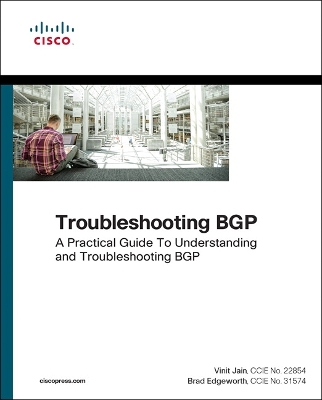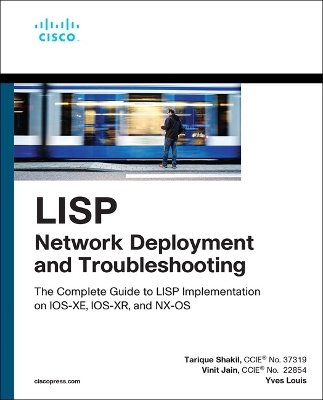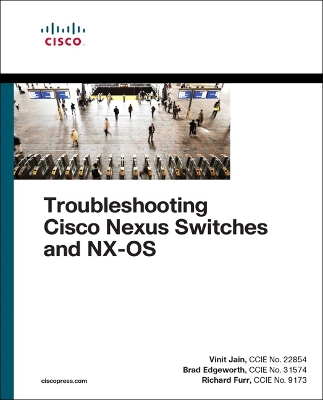Networking Technology
4 total works
The definitive guide to troubleshooting today’s complex BGP networks
This is today’s best single source for the techniques you need to troubleshoot BGP issues in modern Cisco IOS, IOS XR, and NxOS environments. BGP has expanded from being an Internet routing protocol and provides a scalable control plane for a variety of technologies, including MPLS VPNs and VXLAN. Bringing together content previously spread across multiple sources, Troubleshooting BGP describes BGP functions in today’s blended service provider and enterprise environments.
Two expert authors emphasize the BGP-related issues you’re most likely to encounter in real-world deployments, including problems that have caused massive network outages. They fully address convergence and scalability, as well as common concerns such as BGP slow peer, RT constraint filtering, and missing BGP routes. For each issue, key concepts are presented, along with basic configuration, detailed troubleshooting methods, and clear illustrations. Wherever appropriate, OS-specific behaviors are described and analyzed.
Troubleshooting BGP is an indispensable technical resource for all consultants, system/support engineers, and operations professionals working with BGP in even the largest, most complex environments.
· Quickly review the BGP protocol, configuration, and commonly used features
· Master generic troubleshooting methodologies that are relevant to BGP networks
· Troubleshoot BGP peering issues, flapping peers, and dynamic BGP peering
· Resolve issues related to BGP route installation, path selection, or route policies
· Avoid and fix convergence problems
· Address platform issues such as high CPU or memory usage
· Scale BGP using route reflectors, diverse paths, and other advanced features
· Solve problems with BGP edge architectures, multihoming, and load balancing
· Secure BGP inter-domain routing with RPKI
· Mitigate DDoS attacks with RTBH and BGP Flowspec
· Understand common BGP problems with MPLS Layer 3 or Layer 2 VPN services
· Troubleshoot IPv6 BGP for service providers, including 6PE and 6VPE
· Overcome problems with VXLAN BGP EVPN data center deployments
· Fully leverage BGP High Availability features, including GR, NSR, and BFD
· Use new BGP enhancements for link-state distribution or tunnel setup
This book is part of the Networking Technology Series from Cisco Press, which offers networking professionals valuable information for constructing efficient networks, understanding new technologies, and building successful careers.
LISP Network Deployment and Troubleshooting
by Tarique Shakil and Vinit Jain
The LISP overlay protocol helps organizations provide seamless connectivity to devices and workloads wherever they move, enabling open and highly scalable networks with unprecedented flexibility and agility. LISP Network Deployment and Troubleshooting is the single source for understanding, configuring and troubleshooting LISP on Cisco IOS, IOS XR and NX-OS platforms. It brings together comprehensive coverage of how LISP works, how it integrates with leading Cisco platforms, how to configure it for maximum efficiency, and how to troubleshoot LISP-related issues such as scalability and convergence.
Focusing on design and deployment in real production environments, leading Cisco LISP engineers Tarique Shakil and Vinit Jain offer authoritative coverage of deploying LISP, verifying its operation, and optimizing its performance in widely diverse environments. Drawing on their unsurpassed experience supporting LISP deployments, they share detailed configuration examples, templates, and best practices designed to help you succeed with LISP no matter how you intend to use it. Coverage includes:
- Problems LISP solves, current use cases, and powerful emerging applications
- Standards and architecture, including control and data planes, packets, messaging, and communication processes
- LISP IPv4 unicast routing, IPv6 enablement/transition, and multicast
- LISP mobility in traditional data center and VXLAN fabrics
- LISP network virtualization and multi-tenancy
- LISP in the enterprise multi-homed Internet/WAN edge
- Securing, managing, and automating LISP
Troubleshooting Cisco Nexus Switches and NX-OS
by Vinit Jain, Bradley Edgeworth, and Richard Furr
The definitive deep-dive guide to hardware and software troubleshooting on Cisco Nexus switches
The Cisco Nexus platform and NX-OS switch operating system combine to deliver unprecedented speed, capacity, resilience, and flexibility in today's data center networks. Troubleshooting Cisco Nexus Switches and NX-OS is your single reference for quickly identifying and solving problems with these business-critical technologies.
Three expert authors draw on deep experience with large Cisco customers, emphasizing the most common issues in real-world deployments, including problems that have caused major data center outages. Their authoritative, hands-on guidance addresses both features and architecture, helping you troubleshoot both control plane forwarding and data plane/data path problems and use NX-OS APIs to automate and simplify troubleshooting. Throughout, you'll find real-world configurations, intuitive illustrations, and practical insights into key platform-specific behaviors.
This is an indispensable technical resource for all Cisco network consultants, system/support engineers, network operations professionals, and CCNP/CCIE certification candidates working in the data center domain.
· Understand the NX-OS operating system and its powerful troubleshooting tools
· Solve problems with cards, hardware drops, fabrics, and CoPP policies
· Troubleshoot network packet switching and forwarding
· Properly design, implement, and troubleshoot issues related to Virtual Port Channels (VPC and VPC+)
· Optimize routing through filtering or path manipulation
· Optimize IP/IPv6 services and FHRP protocols (including HSRP, VRRP, and Anycast HSRP)
· Troubleshoot EIGRP, OSPF, and IS-IS neighbor relationships and routing paths
· Identify and resolve issues with Nexus route maps
· Locate problems with BGP neighbor adjacencies and enhance path selection
· Troubleshoot high availability components (BFD, SSO, ISSU, and GIR)
· Understand multicast protocols and troubleshooting techniques
· Identify and solve problems with OTV
· Use NX-OS APIs to automate troubleshooting and administrative tasks



